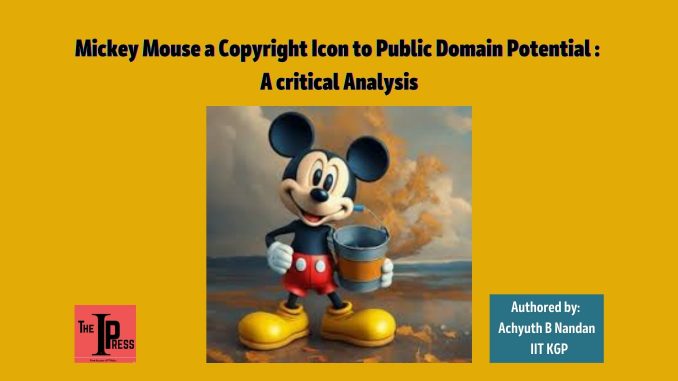
Introduction
The great Mickey Mouse, the beloved cartoon character whose copyright protection by Walt Disney concluded last December. The imminent transition of Mickey Mouse from a copyrighted icon to a public domain figure from Jan 1 2024, signifies a significant milestone in the realm of intellectual property. However, while the original “steamboat willie” version of Mickey Mouse has entered the public domain, its important to note that Disney still holds copyrights on later improved versions of the character. Additionally, Disney retains trademark rights over Mickey Mouse’s name and likeness, which means that character’s use is still subject to legal restrictions.
Before exploring Mickey Mouse’s journey, understand the importance of copyright—an essential right safeguarding creators’ works. It encourages creation and sharing for public benefit by granting exclusive right. “Fair use” exceptions, like satire and certain educational purposes, exist in U.S. copyright laws. Creators hold content ownership for 95 years, after which renowned works enter the public domain. Through the prism of Mickey’s copyright, we delve into the complex interplay of creativity, law, and the public domain.
Unveiling the history of Mickey Mouse’s copyright
In 1928, Mickey Mouse debuted in ‘Steamboat Willie’ and ‘Plane Crazy,’ becoming a cultural phenomenon. Shielded by copyright for almost a century, these creations enter the public domain on New Year’s Day 2024. Jennifer Jenkins anticipates this shift, emphasizing Mickey’s imminent entry, surpassing even characters like Sherlock Holmes and Winnie the Pooh. The significance lies in the intricate 95-year narrative involving Mickey, Disney, and the Public Domain—a drama akin to a Disney movie.
The Copyright Term Extension Act (CTEA), and Mickey Mouse’s copyright are intricately linked through legislative timelines. Enacted in 1998, the CTEA extended copyright terms in the United States. Specifically, it extended the duration to the life of the author plus 70 years and for works of corporate authorship to 95 years from publication or 120 years after creation, whichever came earlier. In the context of Mickey Mouse, whose copyright was set to expire, the CTEA played a crucial role. It ensured that the original works featuring Mickey, such as “Steamboat Willie” from 1928, received an extended period of protection. It is pertinent to note that unlike copyright extension laws in the European Union, the Sonny Bono Act did not reinstate copyrights that had lapsed, making it non-retroactive in that specific aspect. However,
the Act did retroactively extend the protection terms for works that were already copyrighted and existed before its enactment.
| Works (Years) | Protected by | Copyright expired on |
| 1921 | 1909 Copyright Act | 56 years from Publication |
| 1922 | 1976 Copyright Act | January 1, 1998 |
| 1923 | Copyright Term Extension Act | January 1, 2019 |
Starting in 2019, works released in a given year will become part of the public domain at the conclusion of the 95th calendar year from their publication. To illustrate, works published in 1927 transitioned into the public domain on January 1, 2023.
Critics Expose Concerns Over Copyright Term Extensions
Victoria A. Grzelak contends that the Copyright Term Extension Act (CTEA) contradicts the Constitution’s Copyright Clause by seemingly circumventing the requirement for “limited Times” of protection. The retrospective extension of copyright terms may unintentionally lead to an effectively unlimited term, contrary to the Framers’ original intent. Critics, including Grzelak, raise questions about whether copyright laws, particularly the CTEA, should face heightened First Amendment scrutiny due to their impact on speech and press regulation. This criticism highlights concerns about the potential imbalance between safeguarding creators interests and the public’s right to access creative works.
Implications of public Domain entry
What can you do with the Mickey Mouse from January 1, 2024?
It was observed in Klinger v. Conan Doyle Estate that the bedrock principle of copyright that once work enters the public domain it cannot be appropriated as private (intellectual) property, and even the most creative of legal theories cannot trump this tenet.
The public domain entry does not permit an unfettered use of the celebrated Mickey. This can be meticulously analysed using three factors i.e.,
- Trademark
- Newer Copyrights
- Public Domain 2024
Mickey Mouse 1.0, the original featured in Steamboat Willie, is now freely available for the public to copy, share, and build upon. It’s important to note that Disney retains certain rights and trademarks for Mickey Mouse.
A new version of Mickey emerged as Disney secured a copyright with updated features. The original 2-D Steamboat Willie character had rat-like features and a long tail. In 1939, Mickey gained pupils, and the 1940 film ‘The Sorcerer’s Apprentice’ introduced the iconic tall hat and red robe. The transition to 3-D occurred in 2004, with modern Mickeys evolving to appear sweeter and rounder over time.
Distinguishing Trademark and Copyright Protection
Irene Calboli delves on trademark- copyright overlap, in the Trademarks, effective for brand names, slogans, and logos, may overlap with copyright for graphic illustrations like Mickey Mouse. While copyright shields various uses of a work, trademarks focus on names and logos, preventing consumer confusion.
Unlike trademarks that endure indefinitely, copyrights have a fixed term. Trademarks safeguard against confusion as long as they’re in commercial use, while copyrights, expiring over time, deter copying. Trademark cannot be used to fetch perpetual monopoly over copyrighted work, but it can be used as a lawful strategy.
Trademark law, while protecting against consumer confusion, acknowledges the First Amendment’s role in safeguarding freedom of expression. Limitations, like ‘nominative use’ for accurate references, and the Rogers v. Grimaldi case allow accurate references in artistic works, even criticizing brands like Barbie for trying to restrict the use of ‘Barbie’ in song titles and critical photographs. The law permits trademark use in expressive works with artistic relevance and no explicit misrepresentation.
How is Disney Safeguarding Mickey Mouse Amidst the Copyright Countdown?
Stacey Lee explores the implications of the public domain entry, Disney retains control over Mickey Mouse by adapting and securing new copyrights and renewing trademarks. This strategy ensures ongoing protection against infringement, assuring Mickey’s enduring presence. Disney assures that despite the expiration of the Steamboat Willie copyright, Mickey Mouse’s legacy remains intact. A Disney spokesperson emphasizes that people’s associations with the character, Disney’s stories, and authentic products persist. The more modern versions of Mickey remain unaffected, ensuring his continued role as a global ambassador in storytelling, theme park attractions, and merchandise.
While the copyright lapses, Disney retains the trademark on Mickey as a ‘corporate mascot and brand identifier. The company vows to protect against consumer confusion caused by unauthorized uses of Mickey and other iconic characters. Creators are prohibited from producing works that deceptively suggest affiliation with Disney, reinforcing the company’s commitment to safeguarding its intellectual property rights.
Cultural Impact of Mickey Mouse with the Transition
As a symbol of creativity and joy, Mickey’s public domain status could foster new creative interpretations and collaborations. However, concerns linger about potential dilution and loss of control over the character’s consistent representation. The impact on merchandise, theme parks, and storytelling remains uncertain, yet the transition offers an intriguing juncture for evaluating the dynamic relationship between intellectual property and cultural heritage.
Conclusion
In envisioning a balanced future for copyright laws, particularly in light of Mickey Mouse’s entry into the public domain, a forward-thinking approach is essential. Here are key considerations:
- Tiered Copyright System: Introduce a tiered copyright system, extending protection for original works during the creator’s lifetime, while incorporating more flexible terms for widely recognized cultural symbols or characters, such as Mickey Mouse.
- Balancing Rewards and Significance: Acknowledge the importance of rewarding creators, even as we recognize the cultural significance of creations that transcend individual ownership, exemplified by iconic characters like Mickey Mouse.
- Striking a Delicate Balance: Find equilibrium between protecting intellectual property and fostering a robust public domain. Navigate complexities to maintain a dynamic cultural landscape, ensuring that beloved figures like Mickey continue to inspire new generations.
- Incentivizing Contributions: Explore mechanisms to incentivize ongoing creative contributions beyond the initial copyright term, encouraging creators to add new layers to existing cultural touchstones. Moral rights considerations must also be given due significance.
- Forward-Thinking Approach: Embrace change and innovation in copyright laws, ensuring the intellectual property framework remains relevant, equitable, and conducive to creativity in the digital age.
By adopting these suggestions, we not only honor the legacy of creators but also nurture a vibrant cultural heritage, allowing characters like Mickey Mouse to evolve while preserving their timeless appeal for generations to come.

Adv. Achyuth B Nandan
Author
With a keen interest in Geographical Indications, Traditional Knowledge, and Biodiversity Research, Achyuth is particularly enthusiastic about protecting the unique cultural and natural heritage of various communities. His academic pursuits are complemented by active involvement in research projects related to the legal aspects of biodiversity conservation and the preservation of traditional knowledge systems.
Leave a Reply